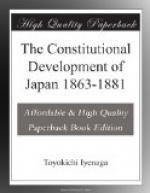The discussion quoted above is a type of the arguments used by the Jo-i party and the Kai-Koku party. The history of Japanese politics from 1853 to 1868 is the history of the struggle between these two parties, each of which soon changed its name. As the Jo-i party allied itself with the court of Kioto, it became the O-sei or Restoration party. As the Kai-Koku party was associated with the court of Shogun, it became the Bakufu party. The struggle ended in the triumph of the Restoration party. But by that time the Jo-i party, from a cause which I shall soon mention, had been completely transformed and converted to the Western ideas.
Among the leaders of the Jo-i party was Nariaki, the old prince of Mito. He belonged to one of the San Kay (three families), out of which Iyeyasu ordered the Shogun to be chosen. He was connected by marriage with the families of the Emperor and the highest Kuges in Miako, and with the wealthiest Daimios. In power the Mito family thus ranked high among the Daimios. Among the scholars the Prince of Mito was popular. The prestige of his great ancestor, the compiler of Dai-Nihon-Shi, had not yet died out. The Prince of Mito was thus naturally looked up to by the scholars as the man of right principles and of noble ideas. A shrewd, clever, and scheming old man, the Prince of Mito now became the defender of the cause of the Emperor and the mouthpiece of the conservative party.
At the head of the Bakufu party was a man of iron and fertile resources, Ii Kamon No Kami. He was the Daimio of Hikone, a castled town and fief on Lake Biwa, in Mino. His revenue was small, being only three hundred and fifty thousand koku. But in position and power none in the empire could rival him. He was the head of the Fudai Daimios. His family was called the Dodai or foundation-stone of the power of the Tokugawa dynasty. His ancestor, Ii Nawo Massa, had been lieutenant-general and right-hand man of Iyeyas. Ii Kamon No Kami, owing to the mental infirmity of the reigning Shogun, had lately become his regent. Bold, ambitious, able, and unscrupulous, Ii was the Richelieu of Japan. From this time on till his assassination on March 23, 1860, he virtually ruled the empire, and, in direct contravention to the imperial will, negotiated with foreign nations, as we have seen, for the opening of ports for trade with them. He was styled the “swaggering prime minister,” and his name was long pronounced with contempt and odium. Lately, however, his good name has been rescued and his fame restored by the noble effort of an able writer, Mr. Saburo Shimada.[6] But this able prime minister fell on March 23, 1860, by the sword of Mito ronins, who alleged, as the pretext of their crime, that “Ii Kamon No Kami had insulted the imperial decree and, careless of the misery of the people, but making foreign intercourse his chief aim, had opened ports.” “The position of the government upon the death of the regent was that of helpless inactivity. The sudden removal of the foremost man of the empire was as the removal of the fly-wheel from a piece of complicated machinery. The whole empire stood aghast, expecting and fearing some great political convulsion."[7]




